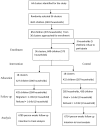Household water chlorination reduces incidence of diarrhea among under-five children in rural Ethiopia: a cluster randomized controlled trial
- PMID: 24194899
- PMCID: PMC3806844
- DOI: 10.1371/journal.pone.0077887
Household water chlorination reduces incidence of diarrhea among under-five children in rural Ethiopia: a cluster randomized controlled trial
Abstract
Background: Household water treatment has been advocated as a means of decreasing the burden of diarrheal diseases among young children in areas where piped and treated water is not available. However, its effect size, the target population that benefit from the intervention, and its acceptability especially in rural population is yet to be determined. The objective of the study was to assess the effectiveness of household water chlorination in reducing incidence of diarrhea among children under-five years of age.
Method: A cluster randomized community trial was conducted in 36 rural neighborhoods of Eastern Ethiopia. Households with at least one child under-five years of age were included in the study. The study compared diarrhea incidence among children who received sodium hypochlorite (liquid bleach) for household water treatment and children who did not receive the water treatment. Generalized Estimation Equation model was used to compute adjusted incidence rate ratio and the corresponding 95% confidence interval.
Result: In this study, the incidence of diarrhea was 4.5 episodes/100 person week observations in the intervention arm compared to 10.4 episodes/100 person week observations in the control arm. A statistically significant reduction in incidence of diarrhea was observed in the intervention group compared to the control (Adjusted IRR = 0.42, 95% CI 0.36-0.48).
Conclusion: Expanding access to household water chlorination can help to substantially reduce child morbidity and achieve millennium development goal until reliable access to safe water is achieved.
Trial registration: ClinicalTrials.gov NCT01376440.
Conflict of interest statement
Figures



References
-
- WHO/UNICEF (2009) Diarrhoea: Why children are still dying and what can be done. Geneva/Newyork: The United Nations Children’s Fund/World Health Organization.
-
- Clasen T, Roberts I, Rabie T, Schmidt W, Cairncross S (2006) Interventions to improve water quality for preventing diarrhoea. Cochrane Database Syst Rev 3: CD004794. - PubMed
-
- UNICEF/WHO (2012) Progress on Drinking Water and Sanitation: 2012 Update. Geneva,Swizerland: The United Nations Children’s Fund/World Health Organization. Available: www.wssinfo.org.
-
- WHO (2012) Rapid assessment of drinking-water quality: a handbook for implementation. Geneva, Swizerland: World Health Organization.
-
- WHO (2007) Combating waterborne disease at the household level. Geneva, Swizerland: World Health Organization.
Publication types
MeSH terms
Substances
Associated data
LinkOut - more resources
Full Text Sources
Other Literature Sources
Medical

